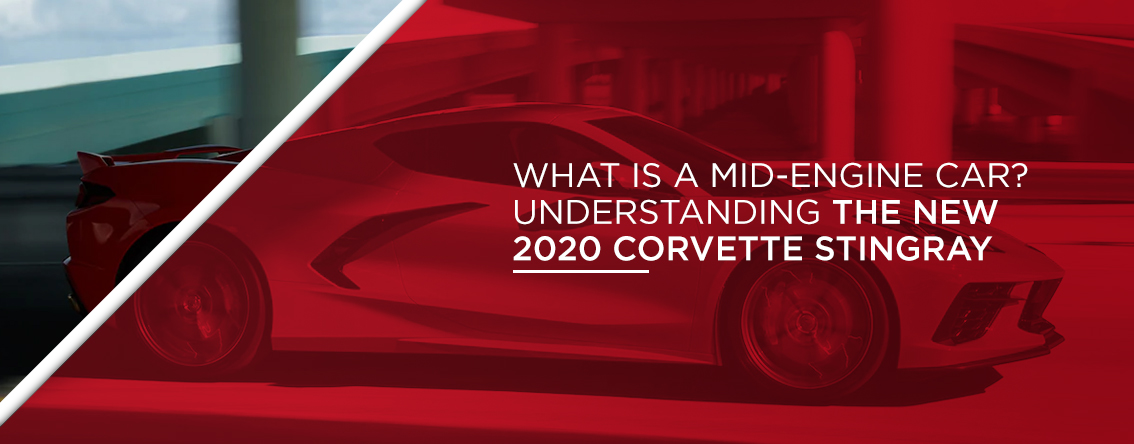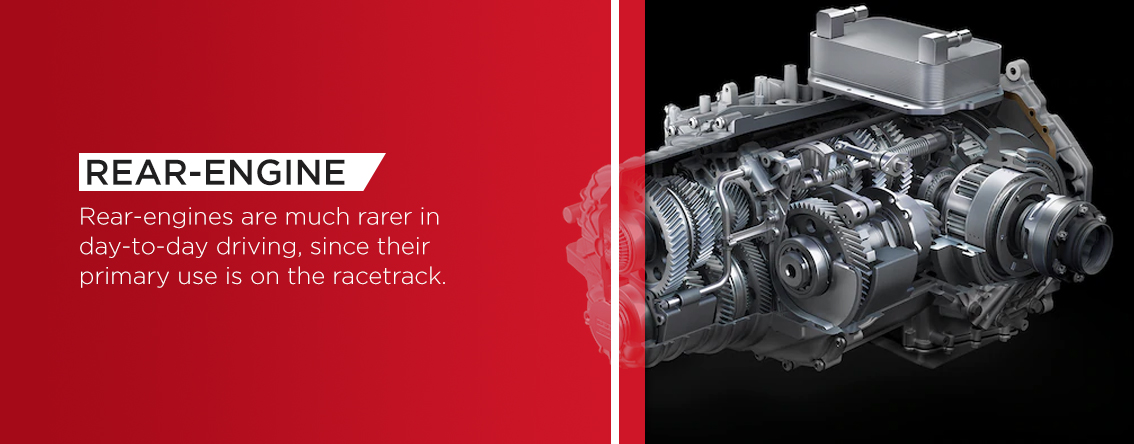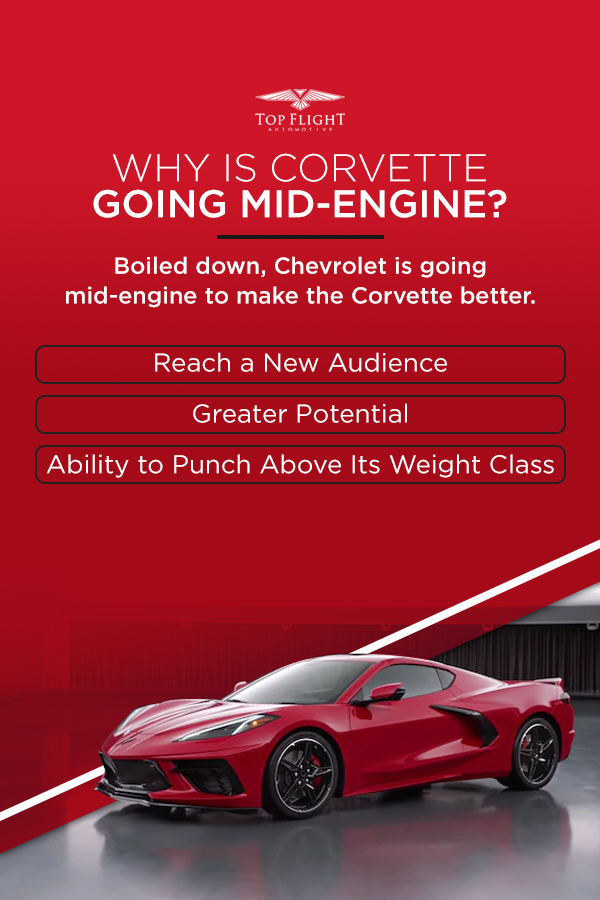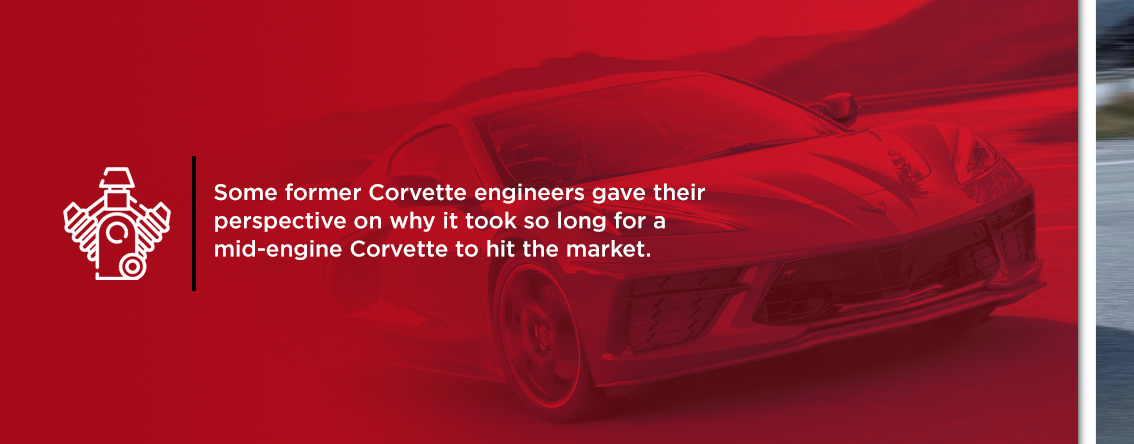
With Corvette using a front-engine since 1953, the 2020 mid-engine Corvette Stingray is a revolutionary step for the company. The mid-engine breaks with tradition to try to create something different than the norm and forge a new path for the Corvette. This new engine is an attempt to improve the sports car and bring it to a new audience.
For those who are interested in purchasing the 2020 Corvette or who are in the market for a new sports car, you should probably know what a mid-engine car is and the advantages it provides before you make a purchase. Once you know more about what a mid-engine vehicle is, you should also know more about why Chevrolet switched to the new engine and what that change means for the sports car.
What Does Mid-Engine Mean?
When people refer to mid-engine cars, they are talking about a vehicle with a four-wheel-drive layout that has an internal combustion engine placed in or near the vehicle’s middle. Sometimes a mid-engine can refer to an engine installed in such a way that it sits in the direct center of gravity between the front and rear axles.
The engine’s placement between the front and rear wheels helps balance the weight placed on both sets of wheels. As a result of this, mid-engine vehicles have earned a reputation for their balance and ability to predictably respond to steering inputs.
Pros and Cons of Front-, Mid- and Rear-Engines
If you’re still wondering, “What is a mid-engine car?” you can learn more by comparing it to the other types of engines. To get a better idea of how mid-engines diverge from others, learn more about the benefits and drawbacks of front-, mid- and rear-engines.
Front-Engine
Most vehicles on the road today are front-engine. One of the primary reasons for this is that the majority of vehicles are front-wheel drive. By placing the engine in the front, it goes right over the wheels and helps them gain better traction. The engine’s placement causes the vehicle to accelerate with balanced weight distribution.
The downside to front-wheel drive, front-engine cars comes down to their tendency to understeer. This understeering results from a loss of traction during acceleration, since the car’s weight goes to the rear wheels. As a result of understeering, front-engine cars are less typical in racing applications where drivers need total control while accelerating to high speeds.
Front-engines used in rear-wheel-drive cars make up for some of these shortcomings, as they create more balance. The engine’s placement and the rear wheels guiding the car cause a more even weight distribution, helping reduce understeering associated with front-wheel-drive cars. Though a rear-wheel drive combined with a front-engine provides a more balanced driving experience, mid-engine vehicles still win out due to their low center of gravity.

Rear-Engine
Rear-engines are much rarer in day-to-day driving, since their primary use is on the racetrack. The reason for their rarity revolves around the steep learning curve for driving with them when compared to other engine setups.
They are popular among professional drivers, however, as they give a great deal of power during a race. By placing the engine in the back, the car’s back wheels receive more traction and control, allowing the car to accelerate faster. In a race, this acceleration and traction can be the difference between a win or a loss.
The engine does have some drawbacks, however, as it can cause issues with oversteering. With all the weight and power in the back of the vehicle, the back of the car often tries to swing to the front. Top sports cars minimize this tendency by pairing the engine with chassis tuning and the best suspension available.
With the higher learning curve and downsides to the engine placement, you’re likely only to see this engine in a minority of contemporary sports cars, like the Porsche 911 — though you can find a larger number of rear-engine vehicles produced before 1980, when the engine was more popular.
Mid-Engine
Due to their placement, many people consider mid-engines the best for handling. The engine’s position in the middle of the car creates more balance between the front and rear of the vehicle. This increased balance leads to greater traction for all four wheels, which helps provide stability when taking corners.
One of the drawbacks to the mid-engine is a lack of cabin space, since it often sits below the spot where you’d usually expect to have a back seat. As a result, mid-engine cars rarely contain more than two seats. In terms of control, it can be difficult to stop the car if it starts to spin due to the low center of gravity. Despite these disadvantages, mid-engines are on the cutting edge, and many sports cars use them.
Rear-Engine vs. Mid-Engine
If you’re in the market for a sports car, you probably aren’t looking for a front-engine, as it’s better for consumer vehicles and everyday driving. With front-engines eliminated, you’ll have the choice between a rear-engine and a mid-engine.
While the rear-engine does have superior acceleration over the other engine types, it’s also harder to control. Drivers will most likely drive their sports cars other than just on a racetrack. The rear-engine control issues could be dangerous, especially at high speeds on the highway. The high learning curve can also be a difficult selling point, since luxury car makers often want to reach a broader audience than just professional drivers with the training to properly handle the cars.
The mid-engine is more popular today for a couple of reasons. For one, the superior balance the engine offers to cars gives them much more accessible handling, allowing for a broader customer base. Along with their ability to take corners with ease and remain balanced, a mid-engine vehicle still provides plenty of acceleration, delivering the power and speed sports car drivers are looking for.
If you’re a professional driver, a rear-engine might be more for you, but if you’re a sports car enthusiast looking for something easier to handle and fun to drive, a mid-engine is likely the better option.
Why Do Cars Use Mid-Engines?
A variety of auto manufacturers use mid-engines for the many advantages they provide to users. For one, engines are usually one of the heaviest parts of the car. Having it between the front and rear axles means you’ll receive greater handling balance. Additionally, since the engine isn’t up front, car designers can improve the aerodynamic efficiency of the vehicle.
In a sports or race car where the engine is in a passenger compartment, it helps to improve the level of torque you can deliver to the rear wheels. All in all, engineers use mid-engines in cars when they are trying to create a vehicle with excellent balance and handling that can still pack a punch.

Why Is Corvette Going Mid-Engine?
Boiled down, Chevrolet is going mid-engine to make the Corvette better. Not only does the mid-engine help the vehicle improve its performance and handling, but it also helps rebrand the Corvette and potentially attract younger sports car buyers. Find out more below about the reasons Corvette might be switching to a mid-engine.
1. Reach a New Audience
One of the primary reasons Chevrolet is switching to a mid-engine for their Corvette Stingray is the ability to reach a new audience. The front-engine has been around for a while, and the company has fallen into the habit of appealing to older people, with the average age of a Corvette owner being 61 years old. While it’s likely Chevy doesn’t want to alienate its older fans, it also wants to start appealing to a younger crowd.
By redesigning the Corvette so that it runs on a mid-engine, the car gets a chance to reinvent itself. The mid-engine helps Chevrolet market the Corvette with a more youthful, innovative image, showing buyers they aren’t afraid to try something new. With a fresh look and the relatively low price point when compared to other sports cars, Chevy is hoping to capture that younger audience, developing a customer base that’ll be there for many decades to come.
2. Greater Potential
There are a couple of different ways a mid-engine gives the Corvette more potential. One of them comes down to growth.
With the Corvette largely appealing to an older audience, many people would often only purchase the car as a one-time-only, nostalgia purchase, connecting the buyer to their youth. Of course, a sale is a sale, and while these nostalgia purchases are welcome, they don’t offer the same level of growth potential most companies want to cultivate. The thinking goes that a younger audience is more likely to be repeat buyers, making multiple Corvette purchases over their life.
Chevrolet is banking on the C8’s mid-engine’s ability to increase the Corvette’s growth potential by also increasing its performance. Selecting the mid-engine delivers a handful of performance benefits to the Corvette. While you might not notice the changes on a day-to-day drive, you’ll be sure to appreciate it when you take the sports car out on a racetrack at a car club event or just down a twisty road.
With the mid-engine, you’ll realize the car drives more consistently and predictably, perfect for times when you’re punching it or heading around tight corners. The mid-engine also facilitates better handling by placing more mass between both axles. By switching, Chevrolet is counting on the greater potential of a sports car that runs on a state-of-the-art mid-engine, both for its ability to attract new customers and the performance boost it provides.
3. Ability to Punch Above Its Weight Class
When you think of other sports car manufacturers like Lamborghini, Ferrari and Porsche, you probably think of incredibly powerful cars and high price tags. The Corvette’s C8 engine makes it possible for Chevy to enter the same conversation of these European sports cars in terms of power, as well as taking away the negative of having to pay hundreds of thousands of dollars for a vehicle.
Though there will undoubtedly always be some sports car snobs who want the most expensive purchase they can find, the Corvette’s ability to go from zero to 60 in under three seconds puts it in direct competition with these more expensive vehicles. Consider that the Corvette Stingray is just under $60,000, while other sports cars offered by the major European brands regularly retail for hundreds of thousands of dollars. If you can get the same performance, why not spend considerably less?
Besides trying to break into the market through top-tier performance and a relatively affordable price, a shift in the color options for the Corvette Stingray also gives it a more youthful appearance, helping it compete more directly with cars that have a younger audience. Exterior paint options like Zeus Bronze, Accelerate Yellow and Rapid Blue are all attempts at attracting a fresh new group of drivers.

Why Did It Take So Long to Get a Corvette C8 Mid-Engine?
Though there are several benefits to using mid-engine vehicles, there have been some challenges to Corvette, and other sports car manufacturers, in making the mid-engine a reality. There have been plans for a mid-engine Corvette for some time, but a variety of issues delayed the implementation of these ideas.
Some former Corvette engineers gave their perspective on why it took so long for a mid-engine Corvette to hit the market. Dave McLellan, Corvette’s chief engineer from 1975 to 1992, discussed how corporate management roundly rejected plans for a mid-engine. In addition to corporate pushback, McLellan also mentioned his observation that Corvette buyers’ lack of desire to move from the traditional layout delayed the change to a mid-engine.
These difficulties would continue after McLellan’s retirement, as Dave Hill, Corvette’s chief engineer from 1992 to 2006, described that the financial climate and concerns about how to make a mid-engine car attractive prevented the adoption of a mid-engine layout. After Hill, a new chief engineer, Tom Wallace, took over and began to make plans for a new mid-engine Corvette. However, there were financial difficulties related to the Great Recession and corporate skepticism that a mid-engine Corvette could turn a profit.
After Wallace’s retirement in 2008, current Corvette chief engineer Tadge Juechter initially delayed creating a mid-engine Corvette, opting instead to launch the popular C7. However, Juechter also understood that the Corvette was beginning to reach the limits of a front-engine in terms of the performance it could offer.
The only way to improve the vehicle’s performance was to switch to a mid-engine. Finally, Juechter had the ammunition he needed to convince management that a mid-engine would be worth the change, as it could offer drivers superior performance. In 2019, the mid-engine Corvette was released and has delivered some stunning performance results.
2020 Mid-Engine Corvette Specs
With the redesign, the 2020 mid-engine Corvette has some seriously impressive power and speed, among other enticing qualities. See some of its most remarkable stats below:
- 495 hp
- 470 lb.-ft. of max available torque
- Zero to 60 in 2.9 seconds
- Top speed of 194 mph
Check out Top Flight Automotive for All Things Corvette
As a leading provider of Corvette parts, accessories, interiors and apparel, Top Flight Automotive is proud to help our customers maintain and customize their Corvettes. We have products, parts and accessories for every generation of Corvette, which means you can find almost any item you’re looking for. As fellow Corvette enthusiasts, our staff is ready to help you find the exact part you need and give you any advice.
Browse our offerings for the 2020 mid-engine Corvette or check out our full selection of Corvette products, no matter the generation. If you have any questions while browsing, don’t hesitate to contact us.











Leave a Response